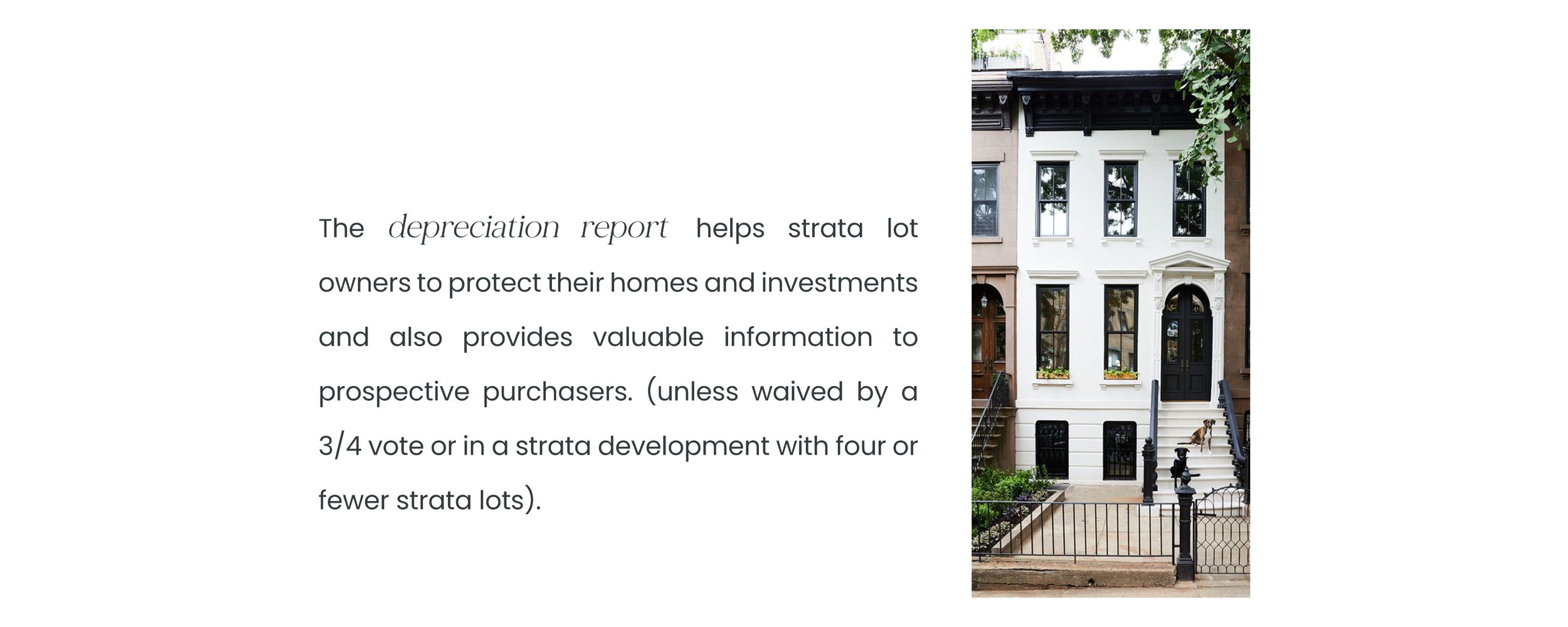The Guide | Depreciation Reports
Under British Columbia’s Strata Property Act and regulations, strata corporations with five or more strata lots must obtain depreciation reports. These depreciation reports must be renewed every three years. Strata corporations may waive the requirement to obtain a depreciation report, or defer a renewal, by passing an annual 3/4 vote.
A strata depreciation report is a thorough written physical assessment of the condition of a strata property that identifies current and future issues that need to be addressed (including the cost estimates). According to provincial regulations, a depreciation report must include an inventory and evaluation of a building's:
structure,
exterior (such as roofs, roof decks, doors, windows and skylights),
systems (such as electrical, heating, plumbing, fire protection and security); and
common amenities (such as fitness room, pool, bike lockers etc).
A depreciation report must include a physical component inventory and evaluation of components which must:
be based on an on-site visual inspection of the site and, where practicable, of the components conducted by the person preparing the depreciation report
include a description and estimated service life over 30 years of those items that comprise the common property, the common assets and those parts of a strata lot or limited common property, or both, that the strata corporation is responsible to maintain or repair under the Strata Property Act, the strata corporation's bylaws or an agreement with an owner
Items to be reviewed include:
the building structure
the building exterior including roofs, roof decks, doors, windows and skylights
the building systems, including the electrical, heating, plumbing, fire protection and security systems
common amenities and facilities (for example: pool, exercise room, guest house etc)
parking facilities and roadways
utilities, including water and sewage
landscaping, including paths, sidewalks, fencing and irrigation
interior finishes, including floor covering and furnishings
green building components
balconies and patios
What is Common Property?
Any part of the land and buildings shown on the strata plan that is not part of a strata lot is common property. For example, in a condominium, common property typically includes hallways, elevators, recreational amenities and building exteriors such as the roof.
Common property is owned collectively by the strata lot owners, as tenants in common. Individual ownership is proportional to the strata lot's unit entitlement as set out in the "Form V: Schedule of Unit Entitlement." The strata corporation exclusively controls the common property. Owners can use the common property except to the extent the Strata Property Act, the regulations, bylaws or rules restrict the use of common property.
All strata corporations must have bylaws and may have rules. Bylaws can govern the management, maintenance, use and control and enjoyment of common property (including limited common property) and common assets within the strata corporation.
A strata corporation may impose a user fee for the use of common property. A strata corporation that wishes to do this must ensure that the amount of the fee is reasonable and the fee is set out in either a bylaw or a rule that has been ratified at the first annual general meeting following the creation of the rule. Examples include user fees for extra parking, clubhouse privileges and extra storage lockers.
The depreciation report must also identify those parts of the common property and limited common property, if any, that individual strata lot owners are responsible to repair and maintain. For example, patios and balconies that are designated limited common property in a highrise "condo tower".
The depreciation report must be completed by a qualified person and this includes a professional engineer registered with Engineers and Geoscientists BC (EGBC).
The financial forecasting section must include:
The anticipated maintenance, repairs and replacement cost for contingency reserve fund common expenses (expenses that usually occur less often than once a year or do not usually occur) projected over 30 years and the factors and assumptions used, including interest rates and inflation rates.
At least 3 cash-flow funding models for the contingency reserve fund over 30 years. Cash flow models could include: the contingency reserve fund; special levies; increased strata fees, borrowing or some combination of these. The models will need to include projected inflation rates and the interest generated from money invested in the contingency reserve fund (CRF). Note: the models are provided in the report for consideration by the strata corporation, they do not have to be adopted.
The current balance of the contingency reserve fund (CRF), minus any expenditures that have been approved but not yet taken from the fund, and how the CRF is currently funded.
Depreciation reports must also include:
A summary of the repair and maintenance work for common expenses that occur less often than once year (i.e. contingency reserve fund expenses)
The date of the report
Any other appropriate information or analysis that the strata corporation or the person providing the depreciation report considers appropriate
The most recent depreciation report, if any, must be attached to the "Form B: the Information Certificate" and provided to buyers.
A strata depreciation report helps strata corporations plan for the repair, replacement and renewal of common property and assets, especially those that require considerable outlay of money, such as roofs, windows, elevators, roads or utilities.
They are also an important part of a buyer's due diligence as they provide insight into future repair and maintenance needs and their associated costs. Realtors should encourage their clients to thoroughly review strata depreciation reports and seek legal or other expert advice before making a buying decision.
Buyers should also understand that a depreciation report covers common property as part of a strata building and not individual units within that building. As a Realtor, be sure to advise buyer clients to get an independent inspection for the specific unit they are considering purchasing.



